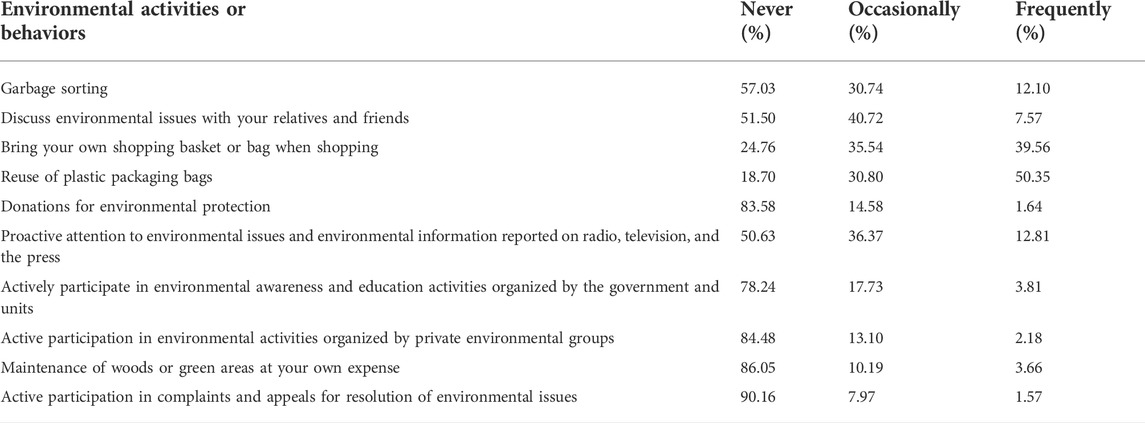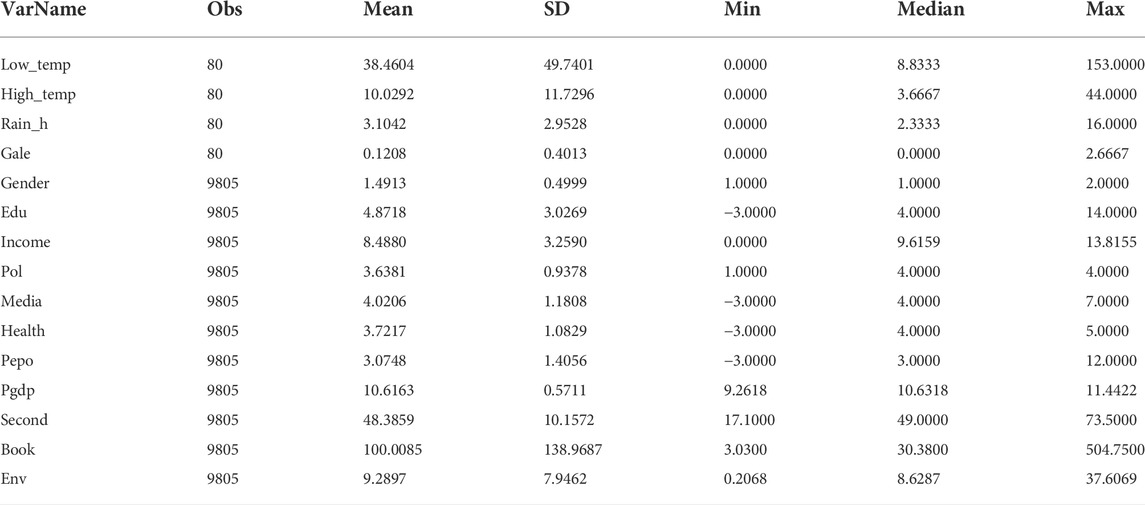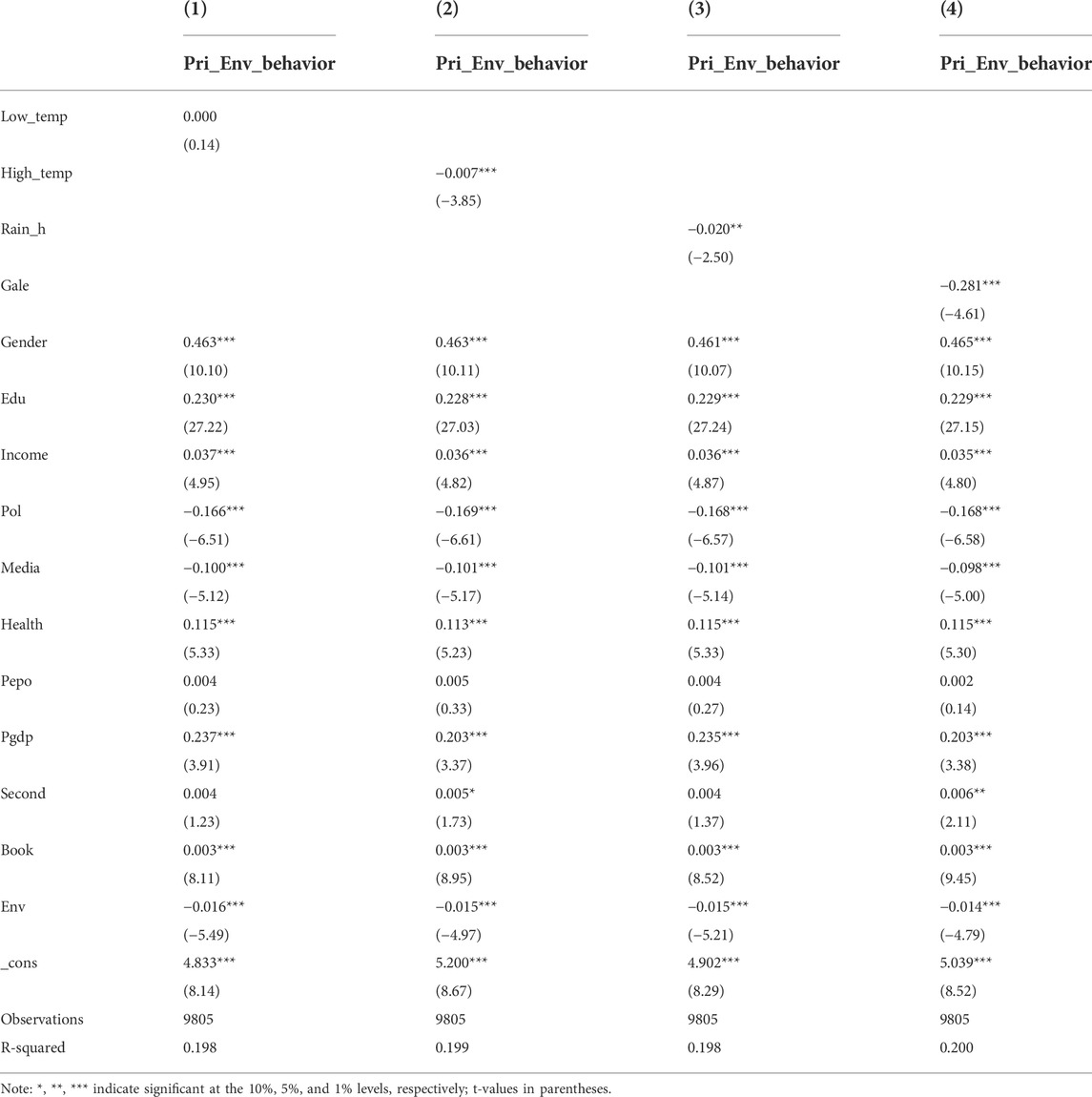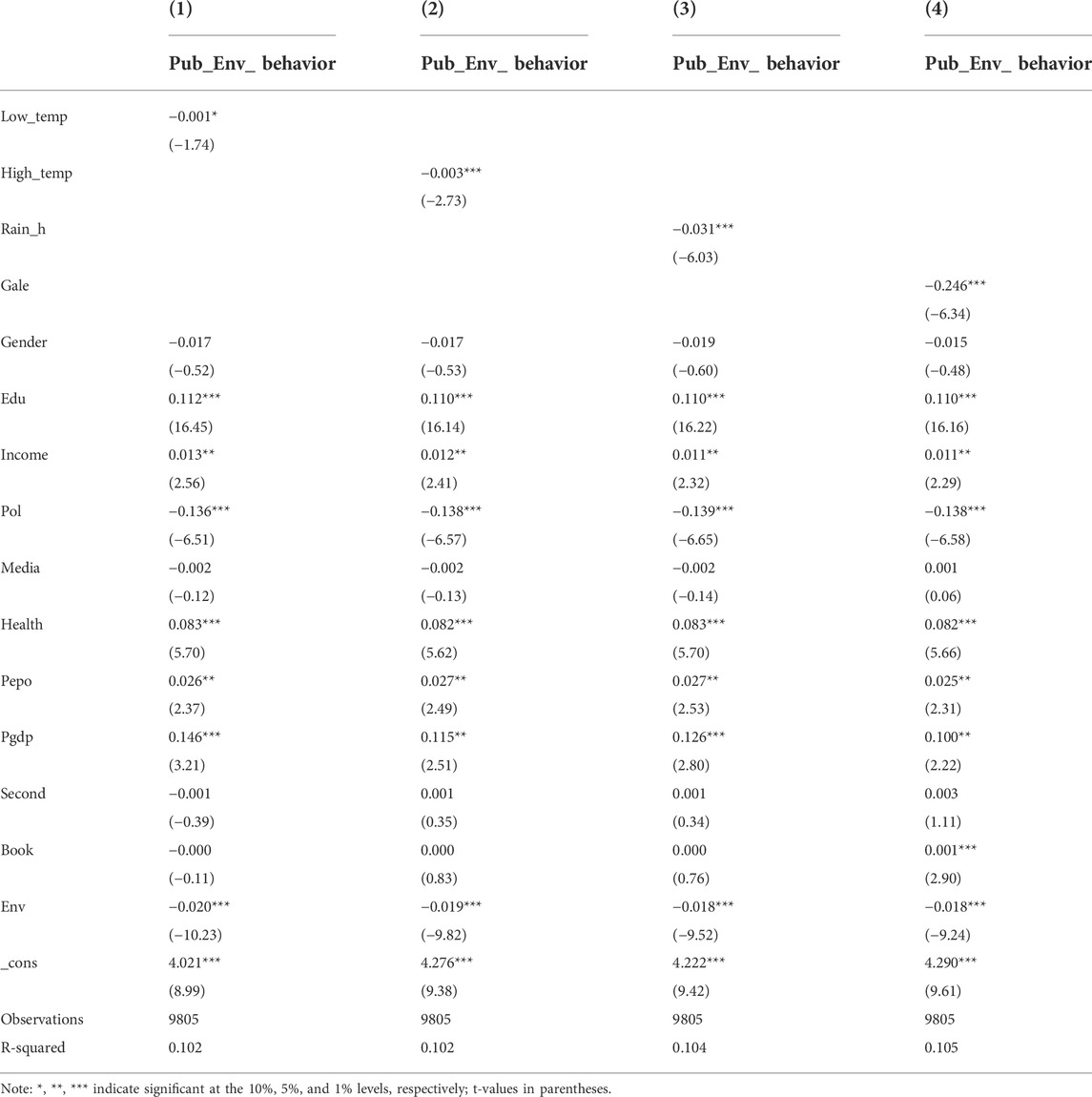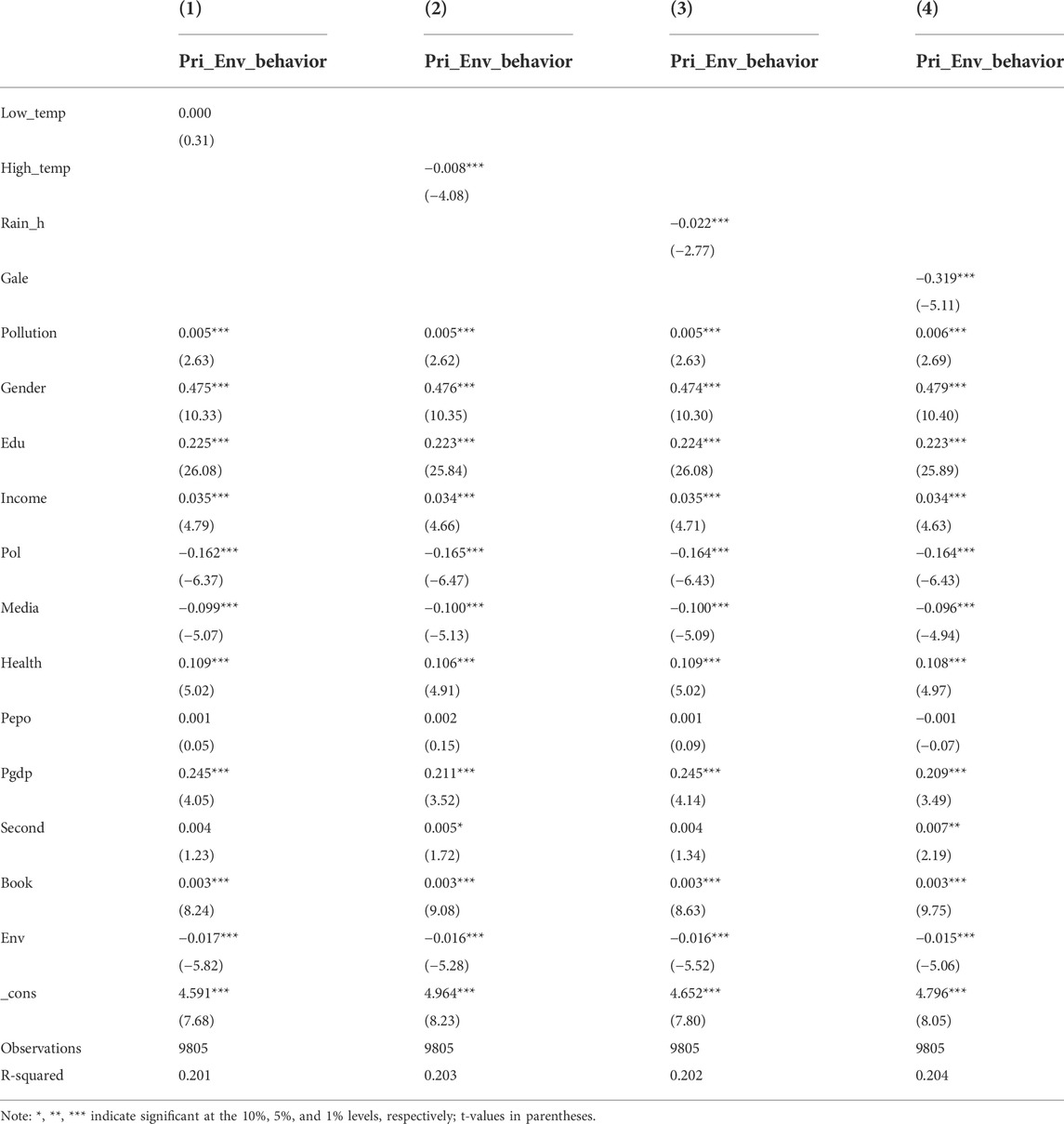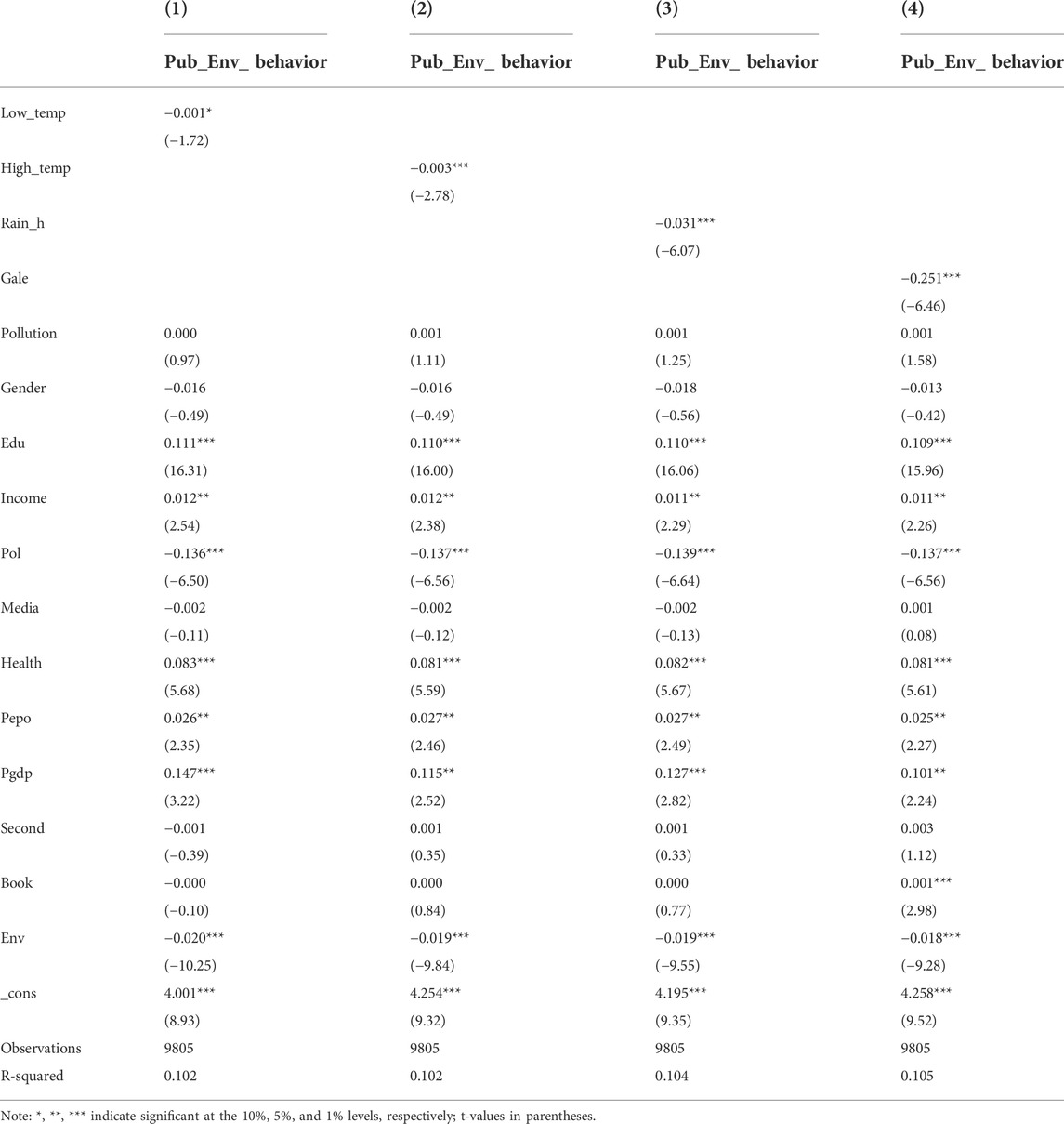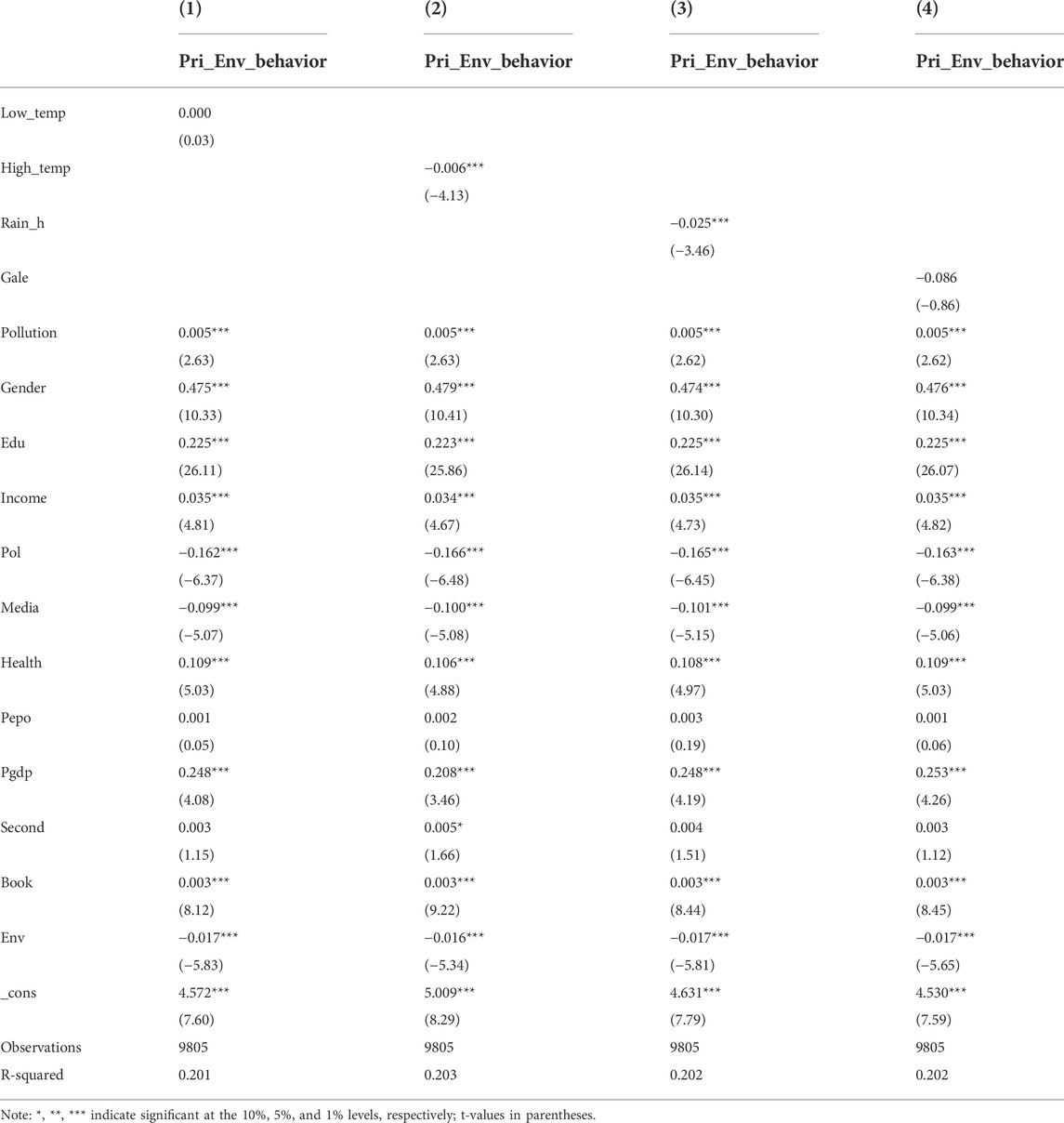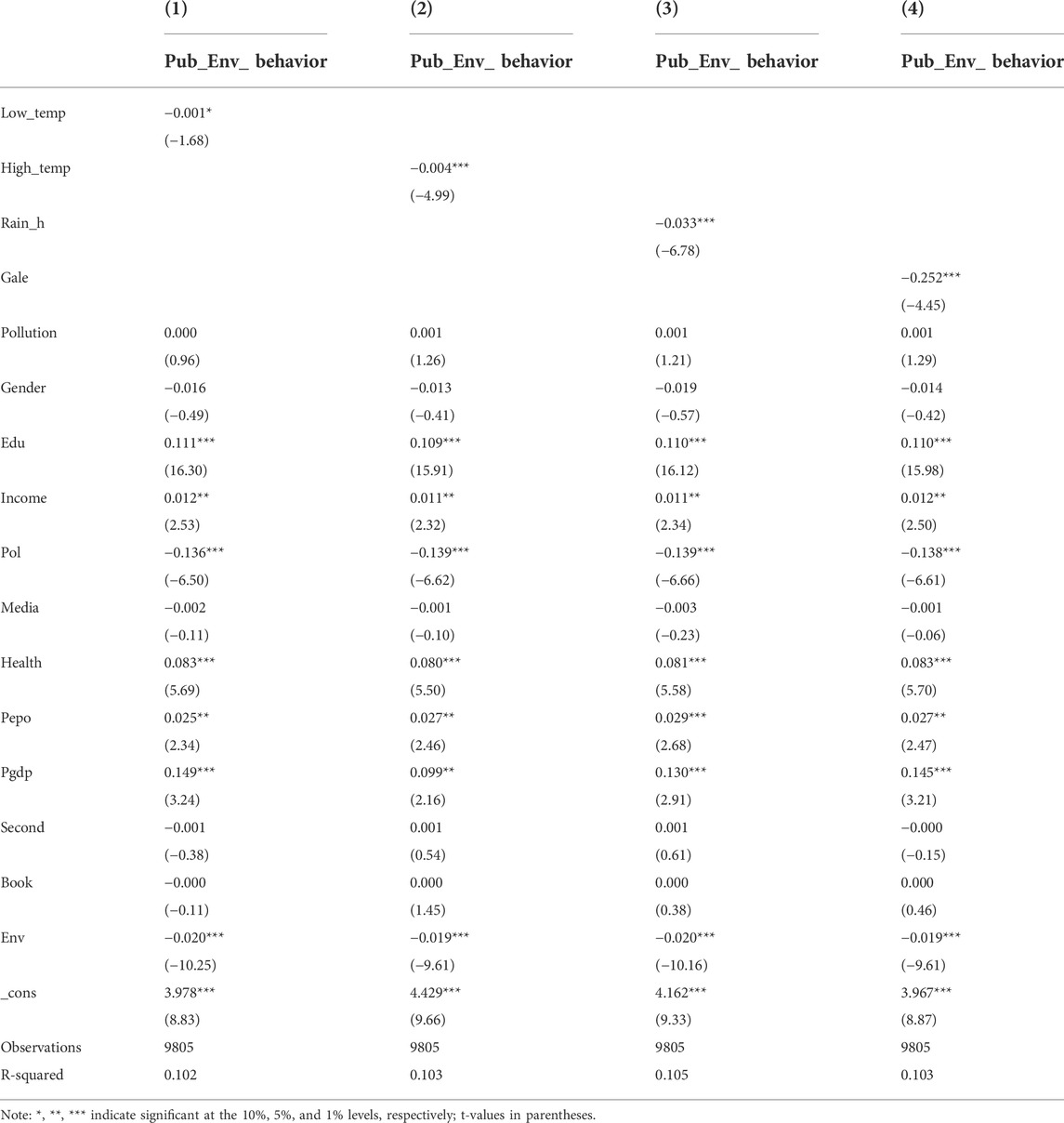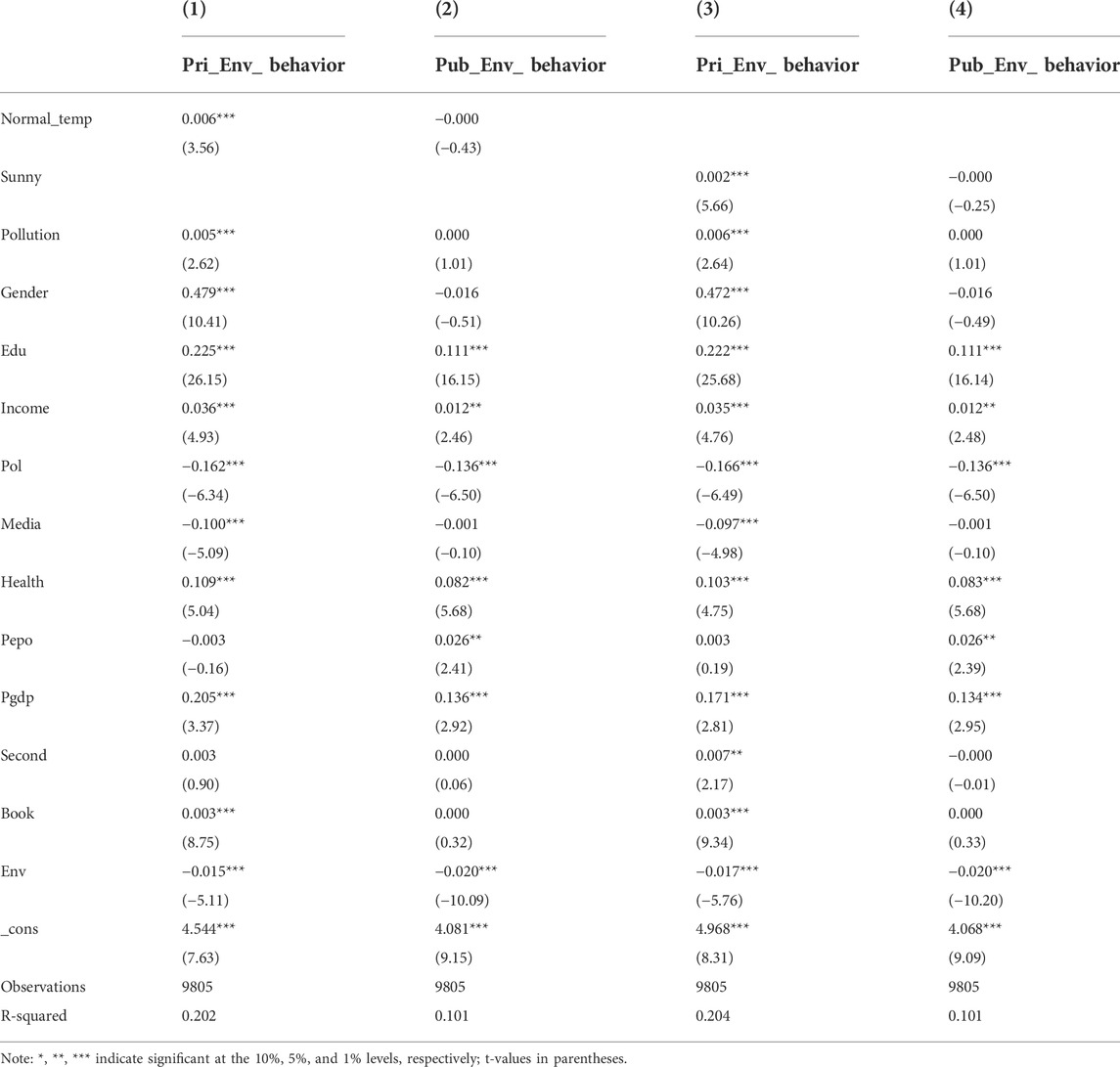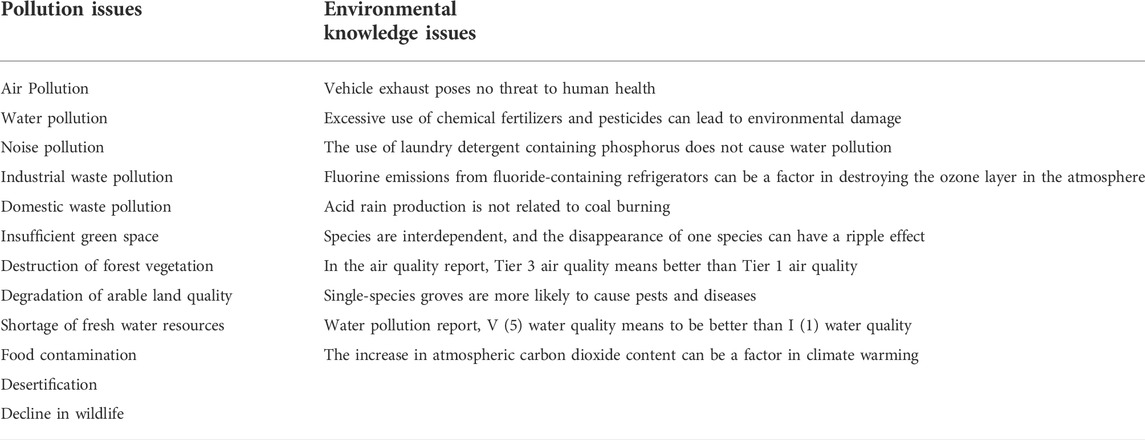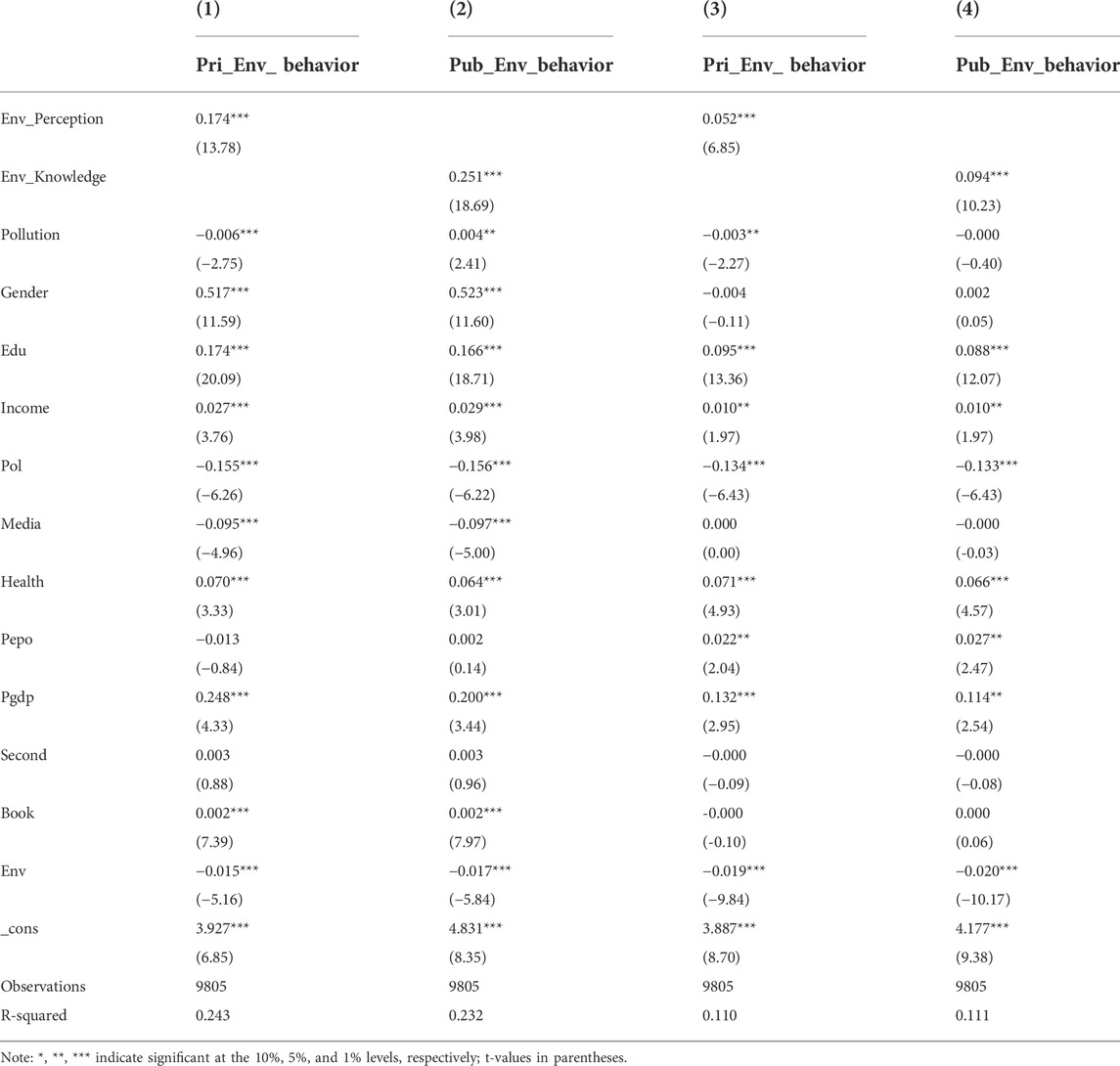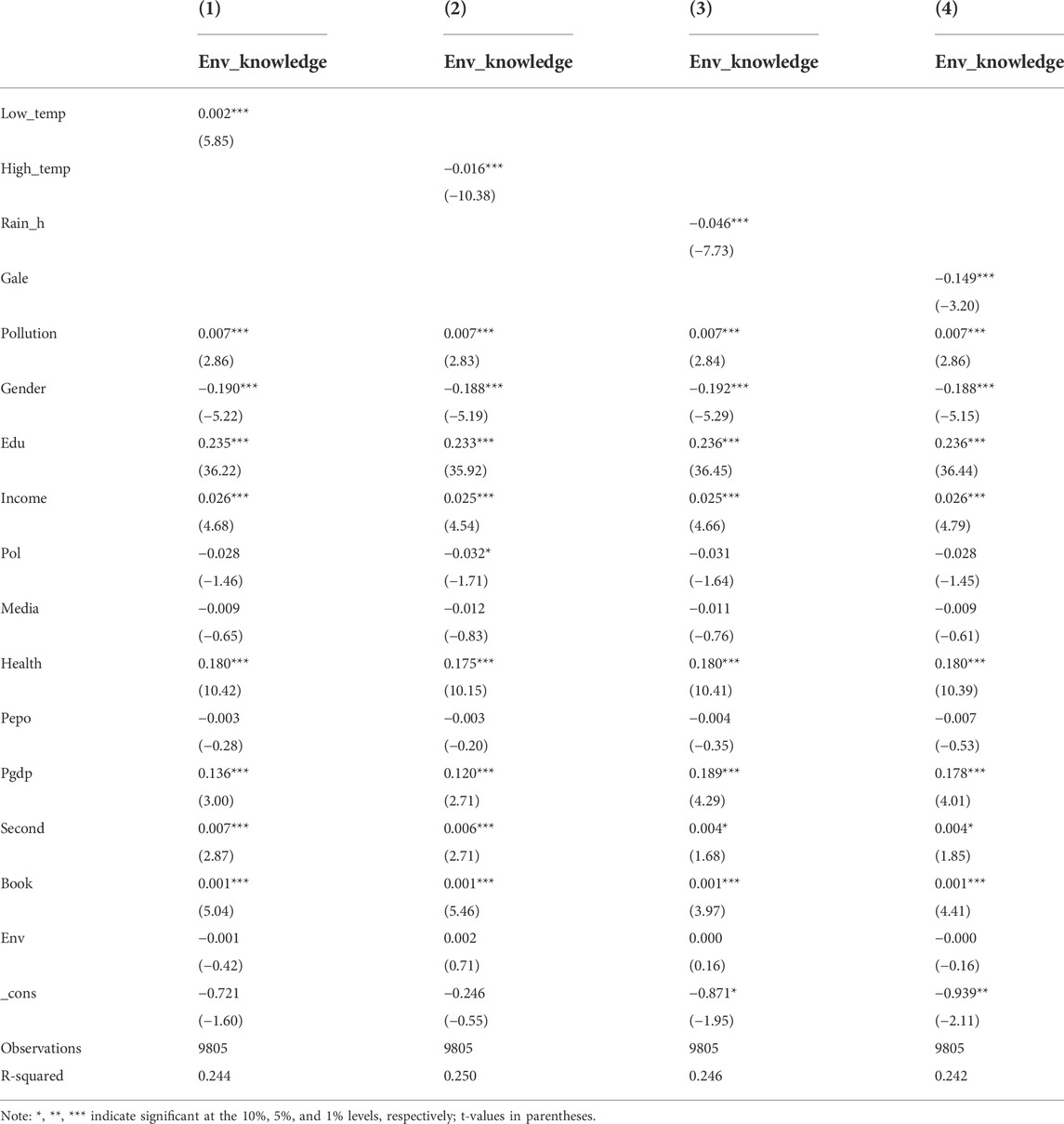- 1School of Finance, Zhongnan University of Economics and Law, Wuhan, China
- 2School of Business, Anhui University of Technology, Ma'anshan, China
Raising residents’ awareness of environmental protection and encouraging their pro-environmental behavior are essential components of promoting the development of green economic transformation. Based on the reality of frequent extreme weather worldwide, this paper establishes a regression model of extreme weather and residents’ pro-environmental behaviors using CGSS2013 data and weather data. The results show that extreme weather has a significant inhibitory effect on residents’ pro-environmental behaviors. Further analysis revealed that extreme weather reduced residents’ environmental perceptions and knowledge, thus reducing their motivation to engage in pro-environmental behaviors.
1 Introduction
With global economic growth, the conflict between economic development and environmental protection issues is becoming more and more prominent. After the reform and opening up, China implemented a crude economic development mode. Excessive resource consumption caused damage to the ecological environment, making China’s economic development costly. Changing the economic development mode is the key to promoting healthy and sustainable development. The 14th Five-Year Plan for National Economic and Social Development of the People’s Republic of China and the Outline of Vision 2035 emphasizes that green and low-carbon development should be accelerated. Also, at the 75th session of the United Nations General Assembly, China proposed that “China’s carbon emissions strive to peak by 2030 and strive to achieve carbon neutrality by 2060” (Carbon Peaking and Carbon Neutrality Goals).
The concept of green development and the Dual Carbon Goals have effectively driven all parties in society to participate in pro-environmental protection actions actively. However, in terms of actual contributions, enterprises have played a major role, and residents’ participation in pro-environmental behaviors needs to be improved. The Citizens’ Ecological and Environmental Behavior Survey Report (2021) shows that only 17.5% of the population shows “high willingness and high behavior” in both the private and public spheres, and more than half of the population lacks actual pro-environmental behavior. The high correlation between residents’ pro-environmental behaviors and environmental quality as well as the fact that residents’ pro-environmental behaviors are insufficient, have triggered scholars’ attention to the mechanisms of pro-environmental behavior formation. Reviewing past research, scholars have conducted extensive studies on social norms (Halvorsen 2012), environmental behavioral convenience (Zhang et al., 2016), individual characteristics (Vining and Ebreo 1990), environmental awareness, and attitudes (Balderjahn 1988; Schultz, Oskamp, and Mainieri 1995). In addition, many scholars have predicted residents’ pro-environmental behavior by developing theories and models, such as the Theory of Planned Behavior (TPB) (Ajzen and Fishbein, 1980), the Model of Responsible Environmental Behavior (Hungerford and Volk, 1990), the Normative Activation Model (NAM) (Steg and de Groot 2010), Value Belief Norm Theory (VBN theory) (Abrahamse and Steg, 2011; Lind et al., 2015), and the Value Identity Personal Norm Model (VIP model) (Ruepert et al., 2016.; van der Werff and Steg, 2016). However, there is a slight lack of research on the impact of external weather on residents’ pro-environmental behaviors. As residents directly perceive environmental changes, extreme weather is more likely to change residents’ environmental perceptions and environmental attitudes, thus influencing environmental behavior.
In recent years, global warming, resource depletion, biodiversity decline, extreme weather and other environmental problems are becoming more frequent, the negative consequences of over-exploitation and use of natural resources have become a growing global concern. Climate change has become one of the most controversial topics. According to the Climate Change Center of China Meteorological Administration, different regions in China are facing natural disasters such as high temperature, cold waves, air pollution and water shortage. Examples include the regional high temperatures in 2013, 2017, and 2022, the extreme rainstorm in Henan Province in July 2021, and the prolonged land stay of typhoon “fireworks.” Data from the China Climate Change Blue Book 2021 shows that China’s climate risk index is increasing yearly. The latest report of the Intergovernmental Panel on Climate Change (IPCC), Climate Change 2022: Impacts, Adaptation and Vulnerability, shows that China will be one of the most severely affected regions if greenhouse gas emissions are not reduced.
Considering both the occurrence of extreme weather events and the fact of climate change, we use CGSS2013 data and weather data, establishing a regression model of extreme weather and residents’ pro-environmental behavior to explore whether extreme weather affects residents’ environmental protection behavior from the perspective of climate change. The empirical results show a significant negative relationship between extreme weather and residents’ pro-environmental behaviors. Residents in areas with frequent extreme weather are more likely to neglect pro-environmental behaviors. We further analyze how extreme weather affects residents’ environmental behavior. The results are consistent with our hypothesis that extreme weather significantly reduces residents’ environmental perceptions and knowledge, thus reducing their motivation to engage in pro-environmental behavior. The results of this paper help to understand the reasons why people in different regions have differences in pro-environmental behaviors, meanwhile, provide valuable references for improving residents’ environmental awareness and motivating them to engage in pro-environmental behaviors.
2 Literature review and research hypothesis
2.1 Environmental behavior and classification
Pro-environmental behavior is a type of environmental behavior. In a broad sense, any purposeful behavior that can reduce negative impacts on the environment is an pro-environmental behavior (Stern, 2000; Kollmuss and Agyeman, 2002). Pro-environmental behavior consists of three types: energy conservation and emission reduction, reuse of waste, and recycling. According to the social sphere, environmental behavior can be divided into two categories: private environmental behavior and public environmental behavior (Hunter, Hatch, and Johnson, 2004). Citizens can achieve environmental protection through behaviors such as complying with environmental regulations, participating in environmental activities, monitoring social environmental issues, or practicing environmental protection directly through their daily personal efforts. A question that deserves attention is what factors influence the public’s environmental protection behavior. Scholars initially viewed public environmental behavior as a public attitude, and believed that environmental behavior is governed by environmental attitudes (Blocker and Eckberg 1997). However, as research continued, Harris (2008) found that people with pro-environmental attitudes do not necessarily have specific behaviors. Attitudes are subjective human intentions, but actual actions may involve cost-benefit considerations. This apparent deviation between environmental attitudes and behaviors is related to intrinsic psychological factors, institutional environments, and socioeconomic conditions. Therefore, we divide the determinants of residents’ environmental behavior into two categories: internal factors, such as public psychology, environmental knowledge, and demographic characteristics, and external factors, such as the level of economic development, social norms, media campaigns, and cost.
2.2 Factors influencing environmental behavior
The first is the internal factors that influence environmental behavior. After classifying environmental behaviors, Stern (2000) examines the causal chain of people’s environmental behaviors and argues that environmental behaviors are closely related to psychological factors. Following the psychological analysis framework, he incorporates values, personal norms, and “beliefs” together in his analytical framework and analyzes individual psychological factors in detail. Following Stern’s research, many studies have focused on environmental awareness and showed great interest in two dimensions: Environmental knowledge and environmental responsibility. In terms of environmental knowledge, Tarrant and Cordell (1997) argued that different social background exhibit large variances in environmental knowledge, which results in significantly different environmental behavior performance. The main reason why environmental knowledge can influence environmental behavior is that it provides targeted guidance for environmental behavior (Kidd and Lee 1997). Environmental responsibility is another dimension of environmental awareness. Most studies have found that the public’s sense of environmental responsibility is positively related to environmental behavior. The more environmentally responsible people are, the more likely they are to engage in environmental behavior (van der Werff and Steg 2016). Theoretically, people with environmental responsibility, would have great environmental perception, this is why research in environmental perception has received so much attention. In addition, some literature has noted that personal characteristics also impact environmental behavior, such as age, gender, education level, etc. (Freymeyer and Johnson 2010).
The second is the external factors that influence environmental behavior. According to the Environmental Kuznets Curve, when economic development reaches an “inflection point,” there is an inverse relationship between environmental pollution and the per capita GDP. As the per capita GDP increases and personal wealth accumulates, the public will have a higher expectation of environmental quality and thus consciously improve their environmental behavior (Diekmann and Franzen 1999). In addition, the effect of economic development on public environmental behavior may also be achieved indirectly by moderating environmental pollution. Many scholars have verified the positive relationship between environmental pollution and public environmental behavior (Freymeyer and Johnson 2010). Also, Ho et al. (2015) argued that mass media subtly influence people’s real life. Media propaganda can effectively guide citizens’ environmental attitudes and influence residents’ environmental behaviors through information transfer and social mobilization mechanisms. Moreover, social pressure, social institutions and structures, and political power can also have some influence on public environmental behavior (Barr 2003; Nolan et al., 2008; Crawford et al., 2010).
2.3 Extreme weather and pro-environmental behavior
At the World Economic Forum 2022 video conference, the United Nations (UN) emphasized that in order to emerge from the current economic and health crisis, and achieve the UN’s sustainable development goals, we urgently need to address three major challenges: inequitable vaccine distribution, reinvigorating the financial system, and climate change.
Climate change is defined as a shift in climate patterns caused primarily by greenhouse gas emissions. The main sources of greenhouse gas emissions are natural systems and human activities. It has been suggested that the Earth’s natural systems can be considered self-balancing, but human activities’ greenhouse gas emissions add additional stress to the Earth system (Yue and Gao, 2018; Edenhofer, 2015).
Stott (2016) argues that climate change is closely related to extreme weather. A recent report released by the National Academy of Sciences (NAS) shows that the intensity, frequency, and duration of extreme weather and climate events have been changing over the past few decades. In particular, the frequency and intensity of both extreme temperatures and extreme precipitation are increasing, which is closely related to human activities.
Research on extreme weather encompasses two main themes, one related to climate change, examining the causes of climate change and related adaptation policies, and the other related to socioeconomic consequences, including the impact of extreme weather on agricultural production (Lesk et al., 2016; Powell and Reinhard, 2016; Cogato et al., 2019), transportation, electricity supply (Panteli and Mancarella, 2015), population health (Khan et al., 2015; Cruz et al., 2020), education (Groppo and Kraehnert, 2017), and public safety (Ebi et al., 2021). The impacts of extreme weather can be divided into direct and indirect impacts. For example, in studies on the impact of agricultural production, extreme weather (high temperatures and heavy rainfall) can act directly on crop growth, resulting in negative impacts. In research on the impact of education, extreme weather can affect the health of the people or the property of the family, which can further affect their normal studies and future education.
According to the previous literature findings, we propose that extreme weather may impact residents’ pro-environmental behavior in the following ways: First, people living in areas where extreme weather is frequent will be more pessimistic about changing environmental conditions. In light of irreversible climate change, they feel their effort is limited and are reluctant to take expensive environmental measures. Moreover, because they subconsciously believe that climate change is difficult to change by human power, the importance of environmental knowledge is doubted. They do not pay attention to environmental knowledge, not to mention taking the initiative to learn environmental knowledge, thus lacking theoretical guidance for pro-environmental behavior. Secondly, extreme weather can also reduce residents’ environmental perceptions. The frequent occurrence of extreme weather makes residents feel upset about environment. Hence, they gradually lose environmental identity and disregard for the environment, and engage less in pro-environmental behaviors. Finally, residents living in areas with frequent extreme weather tend to spend more fighting against extreme weather. They lack the energy and financial resources to participate actively in pro-environmental behaviors. Therefore, we propose the following hypothesis.
Hypothesis 1:. Extreme weather is negatively related to residents’ pro-environmental behaviors.
Hypothesis 2:. Extreme weather affects residents’ pro-environmental behaviors by changing their environmental perceptions and environmental knowledge.
3 Data and empirical methodology
3.1 Data sources
The microdata about residents’ pro-environmental behaviors and other micro control variables come from the 2013 China General Social Survey (hereafter referred to as CGSS 2013), which is implemented by the China Survey and Data Center of the Renmin University of China. The survey population is adults aged 18 and above in mainland China; the sample size of CGSS2013 is 11,438. After filtered to remove sample with missing variables, we finally got 9,805 samples remaining. Macro control variables are obtained from the 2014 China Urban Statistical Yearbook. The data on extreme weather were obtained from China Weather Network.
3.2 Dependent variables
The dependent variable in this paper is the public’s pro-environmental behavior. 2013 CGSS measured the public’s environmental behavior through 10 questions (see Table 1). Referring to previous studies, we categorized the 10 questions and defined items 1–4 and 6 as private environmental behavior, including separating and putting out the garbage, reusing plastic bags, etc.. Items 5 and 7–10 are defined as public environmental behavior, including complaints and appeals ranging from donations for environmental protection to asking for solutions to environmental problems. After that, we give three kinds of answers to each question, divided into never, occasionally, and frequently, with three scores of 1, 2, and 3. To distinguish the degree of individual pro-environmental behavior participation, we summed up the scores of each person, if all of the individual’s answers are frequently, they will get 12 points, and if they are all never, they will get only 4 points.
Classifying pro-environmental behaviors can help us to better distinguish the differences in motivations for different pro-environmental behaviors. Theoretically, compared to private pro-environmental behavior, public pro-environmental behavior has stronger positive externalities and thus brings less incentive to people. But on the contrary, according to the pro-environmental behavior studies, residents engaging in public pro-environmental behavior can get more social reputation for themselves under the influence of external factors. Therefore, the Classifying of pro-environmental behavior makes our study more adequate.
3.3 Independent variables
3.3.1 Extreme weather
There are many extreme weather classifications, and the mainstream literature makes targeted choices according to the research topic. For example, high temperatures and rainfall are often used in studying the impact of extreme weather on agriculture (Lesk et al., 2016). In contrast, low temperature was selected as an explanatory variable in studying the impact of extreme weather on education (Groppo and Kraehnert, 2017). Therefore, selecting extreme weather indicators suitable for the research topic is important. The Chinese version of the Lancet Countdown Population Health and Climate Change found that China faces increasing health risks from climate change. The report mentions the impact of high temperatures and floods on residents’ health. Referring to the relevant reports and literature, we selected several weather indicators that residents easily perceive to measure extreme weather: high temperature, low temperature, heavy rain, and hurricane. The methods for constructing the indicators are as follows: we manually collected daily maximum temperature, minimum temperature, rainfall, and wind level data for 89 cities in China from 2011–20131. Days with a high temperature above 35° is regarded as high temperature, days with a low temperature below −6° is regarded as low temperature, days with heavy rainfall and wind force level greater than eight are regarded as rainfall and gale respectively2. We use the number of the days as the extreme weather variables, and the days were arithmetically averaged (the average of the number of days in each year from 2011 to 2013) to avoid possible abnormal weather fluctuations in 2013.
3.3.2 Macro control variable
In the literature review section, residents’ pro-environmental behaviors are influenced by macro variables such as economic development and environmental pollution. Therefore, we select the following control variables: Economic Development Level, we use each city’s per capita GDP (PGDP) in 2013 as a measure of economic development. Industrial Structure, we select the percentage of regional secondary industry value added to GDP as a measure of industrial structure. Education Development, we select the number of books in public library collection per 100 people as the education development indicator. Environmental Governance Awareness, refer to Han’s (2022) approach, we constructed a synthetic index based on indicators such as industrial SO2 removal rate, industrial wastewater treatment rate, industrial fume and dust removal rate, comprehensive industrial solid waste utilization rate, and domestic waste harmless treatment rate in prefecture-level cities.
3.3.4 Individual control variable
Based on a review of the factors influencing residents’ pro-environmental behavior, the following variables are selected as individual control variables: gender, education, income, health status, media use, household size, and political identity.
3.4 Model construction
Refers to the studies of Shao, Tian, and Fan (2018) and Rice (2006), the following econometric model is constructed.
Behavior represents residents’ pro-environmental behavior, which is divided into private environmental behavior and public environmental behavior. Extrme_climate represents extreme weather, including high temperature, low temperature, heavy rain, and gale. Control_micro represents individual control variables, including gender (Gender), education level (edu), income (income), health status (health), media use (media), household size (pepo), and political identity (pol). Moreover, Control_macro represents the macro control variables, including economic development (pgdp), industrial structure (second), education development (book), and environmental governance awareness (env).
4 Analysis of regression results
4.1 Descriptive statistics
Table 2 reports the results of descriptive statistics. On the distribution of extreme weather, it can be seen that extreme weathers vary widely among the 80 cities3. Some cities have low-temperature weather for nearly half of the year, while some do not have low-temperature weather throughout the year. Similarly, high temperature occurs in some cities for more than 40 days, while some cities never have it. In contrast, heavy rainfall and gale vary less from city to city, but still have a larger standard deviation compared to the mean value. All of these indicate that the sample selection for this paper’s empirical study can reflect the climatic characteristics of most areas of China. The sample selection is reasonable and representative. Data about residents’ pro-environmental behavior are presented in the variable descriptions. The distribution of other control variables is consistent with reality.
4.2 Main regression
Table 3 shows the effect of extreme weather on residents’ private pro-environmental behavior. We can see no significant correlation between low temperature and residents’ private pro-environmental behavior. At the same time, high temperature, heavy rain, and gale negatively affect residents’ private pro-environmental behavior. The more frequent the extreme weather, the fewer residents will engage in private pro-environmental practices. The result is consistent with the previous hypothesis. Instead of making residents more concerned about the environment, extreme weather makes people more reluctant to engage in pro-environmental behaviors. For the individual control variables, gender, education, income, health, and political background correlate with private pro-environmental behavior4. For the macro control variables, private pro-environmental behavior is higher in regions with good economic development and high educational development, which is also consistent with the theory of environmental economics.
Although the specific motivations for residents to engage in public and private pro-environmental behaviors differ, the impact of extreme weather on both is consistent. Compared to Table 3, Table 4 shows a significant negative correlation between low-temperature and public pro-environmental behavior. For control variables, gender, media use, and the number of household members show differences, indicating that there are indeed some differences in the motivational aspects of private and public pro-environmental behavior. The results suggest that residents engage in environmental behavior in various ways and motivations, but are consistently influenced by extreme weather.
4.3 Robustness test
Extreme weather and pollution are two critical aspects of environmental problems. In order to make the effect of extreme weather on residents’ pro-environmental behavior more credible, Tables 5, 6, 7, and 8 add environmental pollution status to the model to control for the effect of environmental pollution on residents’ pro-environmental behavior. The environmental pollution status is also taken from the CGSS 2013, which has some questions about environmental pollution. The residents’ answers can better reflect the level of environmental pollution. After adding environmental pollution variable, the results of the two tables remain consistent, which indicates the robustness of the previous results.
Secondly, in this paper, to avoid the influence of extreme values, we use the average of days (extreme weather) counts for 2011, 2012, and 2013 3 years in the main regression. While the 2013 questionnaire may be more susceptible to the influence of climate change in the year 2013, as a supplement, we replace the extreme weather variables of the year 2013 and re-run the regression, the results remain consistent with the main regression. See Tables 7, 8 for details.
Finally, we re-run the regression using normal weather as the independent variable and compare the difference with the main regression. In this part, we use the number of days with a maximum temperature of [24–30] degrees throughout the year as an indicator of normal weather. This setting avoids a significant negative correlation with the number of high-temperature days, resulting in a simple inverse of the results. In addition, the number of sunny days was used to replace heavy rain days. Due to the lack of an accepted definition of comfort in terms of wind level and residential comfort, the control regression for gale weather was not done here. The results in Table 9 show a significant increase in private pro-environmental behavior in areas with more normal days, although there is no significant correlation between the number of normal days and public pro-environmental behavior. The results show that normal weather can encourage residents engage in environmental behavior, and previous results were proven in another way.
5 Further analysis
According to the results of the main regression, both private and public pro-environmental behaviors of residents decreased in areas with frequent extreme weather. As mentioned in the previous analysis section, the frequent occurrence of extreme weather leads to a decrease in residents’ responsibility of the environment and a lack of attention to environmental-related knowledge, which eventually leads to numbness to environmental issues. Therefore, compared to areas with other areas, residents in areas with frequent extreme weather are less likely to engage in pro-environmental behaviors.
To test whether these mechanisms are valid, we use the CGSS2013 research data to construct indicators of environmental perception and environmental knowledge. There are some questions on environmental perception in CGSS 2013 (see Table 10 for specific questions). The 12 questions are graded with one point for knowing and 0 for ignorance, and the score is added up to determine the level of environmental perception (0–12). Knowing Similarly, environmental knowledge comes from the answer to environmental questions (see Table 10 for specific questions), one point for correct and 0 for incorrect or not knowing. The final score of environmental knowledge varies from 0–10. The regression model follows the previous, and the control variables were kept consistent with the main regression.
First, we verify whether residents’ pro-environmental behavior is influenced by environmental perception and knowledge. Table 11 shows the results of environmental perception and knowledge on private and public pro-environmental behavior. The results show that environmental perception and knowledge are significantly and positively related to residents’ pro-environmental behavior. Residents with stronger environmental perception and better environmental knowledge show more positive behavior in both private and public pro-environmental behavior.
After that, we verify the relationship between extreme weather and environmental perception and environmental knowledge, respectively. Table 12 and 13 show the regression results of extreme weather with environmental perception and knowledge, respectively. The results in Table 12 show that extreme weather negatively correlates with environmental perception, except for low temperature, which is significantly positively correlated with environmental perception. The result corresponds to the non-significant coefficient of low temperature and residents’ private pro-environmental behavior in the previous regression. Low temperature does not have a significant effect on residents’ private pro-environmental behavior because it positively affects residents’ environmental perception.
The results in Table 13 remain consistent with those in Table 12, except the low temperature, other extreme weathers are all negatively correlated with environmental knowledge. The results in Tables 12 and 13 confirm that the effect of extreme weather on residents’ pro-environmental behavior is achieved by influencing residents’ environmental perception and environmental knowledge.
6 Conclusion and recommendations
In this paper, we use CGSS2013 data and historical weather data to establish a regression model to investigate the relationship between extreme weather and pro-environmental behavior of residents. The results show that extreme weather negatively affects residents’ private and public pro-environmental behaviors. Residents in areas where extreme weather is frequent are more likely to neglect pro-environmental behaviors. The empirical results remain robust after adding environmental pollution status, changing the extreme weather metric interval, and using normal weather for control regressions. In further analysis, we tested the mechanisms of the main regression. Consistent with the hypothesis, extreme weather affects environmental behavior performance by reducing residents’ environmental perception and environmental knowledge.
The implications of this paper are as follows. First, residents in regions with frequent extreme weather are less likely to participate in pro-environmental behavior. For regional differences in residents’ environmental behavior, special attention should be given to regions with frequent extreme weather and encourage residents to participate in pro-environmental behavior. Second, residents’ pro-environmental behavior is influenced by many factors, among which environmental perception and knowledge are essential. To improve environmental perception, departments should actively organize environmental protection activities to increase residents’ environmental participation, consciously cultivate residents’ environmental perception, and at the same time, strengthen publicity to raise residents’ awareness of environmental protection. In order to improve environmental knowledge, we need to strengthen the investment in environmental education in schools and support the propaganda of environmental knowledge in daily life. With an excellent social learning environment for environmental protection, people of all ages can receive adequate environmental knowledge to guide their environmental behavior. Finally, residents’ pro-environmental behaviors are influenced by internal and external factors, so we should combine internal and external factors effectively. In the microscopic aspect, we should pay attention to cultivating residents’ awareness of environmental protection. In the macroscopic aspect, we should develop a healthy concept of environmental protection. In this process, the government should practice the concept of green development from top to bottom and pay attention to moral incentives (Edenhofer, 2015; Han and Wang, 2022).
Data availability statement
Publicly available datasets were analyzed in this study. This data can be found here: 2013 China General Social Survey, implemented by the China Survey and Data Center of the Renmin University of China.
Author contributions
ZH: Data collection, regression, and preparation of original draft. YW: Software, writing review and editing. YiW: Ideas, framework, editing. All authors contributed to the article and approved the submitted version.
Conflict of interest
The authors declare that the research was conducted in the absence of any commercial or financial relationships that could be construed as a potential conflict of interest.
Publisher’s note
All claims expressed in this article are solely those of the authors and do not necessarily represent those of their affiliated organizations, or those of the publisher, the editors and the reviewers. Any product that may be evaluated in this article, or claim that may be made by its manufacturer, is not guaranteed or endorsed by the publisher.
Footnotes
1The 89 cities correspond to the cities in the CGSS 2013 survey report. Following relevant laws, regulations and the basic principles of scientific research ethics, CGSS keeps the names, geographical locations, and administrative codes of the surveyed counties (districts) and village committees strictly confidential to protect the survey respondents’ privacy. So this paper does not do a detailed comparative analysis for the regions. The historical data of the China Weather Network was recorded from 2011, so the weather data from 2011 to 2013 were selected.
2In Chinese meteorology, a temperature above 35°C can be called “high-temperature weather.” A yellow warning will be given when the daily maximum temperature is above 35°C for three consecutive days; a low-temperature warning will be given when the temperature is below −15°C, but since the probability of −15°C is low, we adopt −6°C as the low-temperature indicator; Chinese meteorology stipulates that a heavy rainfall of 50 mm or more in 24 h is called “heavy rain.” The disaster in Zhengzhou in 2021 was caused by heavy rainfall; wind force eight or above can break trees, which is more destructive.
3Due to the missing macro variables in some of the 89 cities, only 80 cities are included in the final sample.
4The political context data in this paper uses a continuous variable, with party members assigned a value of 1. The negative correlation results indicate that the lower the value, the more private environmental behavior of residents.
References
Abrahamse, W., and Steg, L. (2011). Factors related to household energy use and intention to reduce it: The role of psychological and socio-demographic variables. Hum. Ecol. Rev. 18 (1), 30–40.
Ajzen, I., and Fishbein, M. (1980). Understanding attitudes and predicting social behavior. Englewood Cliffs, NJ: Prentice Hall.
Balderjahn, I. (1988). Personality variables and environmental attitudes as predictors of ecologically responsible consumption patterns. J. Bus. Res. 17 (1), 51–56. doi:10.1016/0148-2963(88)90022-7
Barr, S. (2003). Strategies for sustainability: Citizens and responsible environmental behaviour. Area 35 (3), 227–240. doi:10.1111/1475-4762.00172
Blocker, T. J., and Eckberg, D. L. (1997). Gender and environmentalism: Results from the 1993 general social survey. Soc. Sci. Q. 78 (4), 841–858.
Cogato, A., Meggio, F., De Antoni Migliorati, M., and Marinello, F. (2019). Extreme weather events in agriculture: A systematic review. Sustainability 11 (9), 2547. doi:10.3390/su11092547
Crawford, E. R., LePine, J. A., and Rich, B. L. (2010). Linking job demands and resources to employee engagement and burnout: A theoretical extension and meta-analytic test. J. Appl. Psychol. 95 (5), 834–848. doi:10.1037/a0019364
Cruz, J., White, P. C. L., Bell, A., and Coventry, P. A. (2020). Effect of extreme weather events on mental health: A narrative synthesis and meta-analysis for the UK. Int. J. Environ. Res. Public Health 17 (22), 8581. doi:10.3390/ijerph17228581
Diekmann, A., and Franzen, A. (1999). The wealth of Nations and environmental concern. Environ. Behav. 31 (4), 540–549. doi:10.1177/00139169921972227
Ebi, K. L., Vanos, J., Baldwin, J. W., Bell, J. E., Hondula, D. M., Errett, N. A., et al. (2021). Extreme weather and climate change: Population health and health system implications. Annu. Rev. Public Health 42, 293–315. doi:10.1146/annurev-publhealth-012420-105026
Edenhofer, O. (2015). Climate change 2014: Mitigation of climate change. Cambridge University Press.
Freymeyer, R. H., and Johnson, B. E. (2010). A cross-cultural investigation of factors influencing environmental actions. Sociol. Spectr. 30 (2), 184–195. doi:10.1080/02732170903496075
Groppo, V., and Kraehnert, K. (2017). The impact of extreme weather events on education. J. Popul. Econ. 30 (2), 433–472. doi:10.1007/s00148-016-0628-6
Halvorsen, B. (2012). Effects of norms and policy incentives on household recycling: An international comparison. Resour. Conservation Recycl. 67, 18–26. doi:10.1016/j.resconrec.2012.06.008
Han, Z., and Wang, Y. (2022). Does high-speed rail promote corporate green innovation? Appl. Econ. Lett., 1–7. doi:10.1080/13504851.2022.2116388
Harris, P. G. (2008). Green or Brown? Environmental attitudes and governance in greater China. Nat. Cult. 3 (2), 151–182. doi:10.3167/nc.2008.030202
Ho, S. S., Liao, Y., and Rosenthal, S. (2015). Applying the theory of planned behavior and media dependency theory: Predictors of public pro-environmental behavioral intentions in Singapore. Environ. Commun. 9 (1), 77–99. doi:10.1080/17524032.2014.932819
Hungerford, H. R., and Volk, T. L. (1990). Changing learner behavior through environmental education. J. Environ. Educ. 21 (3), 8–21. doi:10.1080/00958964.1990.10753743
Hunter, L. M., Hatch, A., and Johnson, A. (2004). Cross-national gender variation in environmental behaviors. Soc. Sci. Q. 85 (3), 677–694. doi:10.1111/j.0038-4941.2004.00239.x
Khan, S. J., Deere, D., Leusch, F. D. L., Humpage, A., Jenkins, M., and Cunliffe, D. (2015). Extreme weather events: Should drinking water quality management systems adapt to changing risk profiles? Water Res. 85, 124–136. doi:10.1016/j.watres.2015.08.018
Kidd, Q., and Lee, A.-R. (1997). Postmaterialist values and the environment: A critique and reappraisal. Soc. Sci. Q. 78 (1), 1–15.
Kollmuss, A., and Agyeman, J. (2002). Mind the Gap: Why do people act environmentally and what are the barriers to pro-environmental behavior? Environ. Educ. Res. 8 (3), 239–260. doi:10.1080/13504620220145401
Lesk, C., Rowhani, P., and Ramankutty, N. (2016). Influence of extreme weather disasters on global crop production. Nature 529 (7584), 84–87. doi:10.1038/nature16467
Lind, H. B., Nordfjærn, T., Jørgensen, S. H., and Rundmo, T. (2015). The value-belief-norm theory, personal norms and sustainable travel mode choice in urban areas. J. Environ. Psychol. 44, 119–125. doi:10.1016/j.jenvp.2015.06.001
Nolan, J. M., Schultz, P. W., Cialdini, R. B., Goldstein, N. J., and Griskevicius, V. (2008). Normative social influence is underdetected. Pers. Soc. Psychol. Bull. 34 (7), 913–923. doi:10.1177/0146167208316691
Panteli, M., and Mancarella, P. (2015). Influence of extreme weather and climate change on the resilience of power systems: Impacts and possible mitigation strategies. Electr. Power Syst. Res. 127, 259–270. doi:10.1016/j.epsr.2015.06.012
Powell, J. P., and Reinhard, S. (2016). Measuring the effects of extreme weather events on yields. Weather Clim. Extrem. 12, 69–79. doi:10.1016/j.wace.2016.02.003
Rice, G. (2006). Pro-environmental behavior in Egypt: Is there a role for islamic environmental ethics? J. Bus. Ethics 65 (4), 373–390. doi:10.1007/s10551-006-0010-9
Ruepert, A., Keizer, K., Steg, L., Maricchiolo, F., Carrus, G., Dumitru, A., et al. (2016). Environmental considerations in the organizational context: A pathway to pro-environmental behaviour at work. Energy Res. Soc. Sci. 17, 59–70. doi:10.1016/j.erss.2016.04.004
Schultz, P. W., Oskamp, S., and Mainieri, T. (1995). Who recycles and when? A review of personal and situational factors. J. Environ. Psychol. 15 (2), 105–121. doi:10.1016/0272-4944(95)90019-5
Shao, S., Tian, Z., and Fan, M. (2018). Do the rich have stronger willingness to pay for environmental protection? New evidence from a survey in China. World Dev. 105, 83–94. doi:10.1016/j.worlddev.2017.12.033
Steg, L., and de Groot, J. (2010). Explaining prosocial intentions: Testing causal relationships in the norm activation model. Br. J. Soc. Psychol. 49 (4), 725–743. doi:10.1348/014466609X477745
Stern, P. C. (2000). New environmental theories: Toward a coherent theory of environmentally significant behavior. J. Soc. Issues 56 (3), 407–424. doi:10.1111/0022-4537.00175
Stott, P. (2016). How climate change affects extreme weather events. Science 352 (6293), 1517–1518. doi:10.1126/science.aaf7271
Tarrant, M. A., and Cordell, H. K. (1997). The effect of respondent characteristics on general environmental attitude-behavior correspondence. Environ. Behav. 29 (5), 618–637. doi:10.1177/0013916597295002
van der Werff, E., and Steg, L. (2016). The psychology of participation and interest in smart energy systems: Comparing the value-belief-norm theory and the value-identity-personal norm model. Energy Res. Soc. Sci. 22, 107–114. doi:10.1016/j.erss.2016.08.022
Vining, J., and Ebreo, A. (1990). What makes a recycler? Environ. Behav. 22 (1), 55–73. doi:10.1177/0013916590221003
Yue, X.-L., and Gao, Q.-X. (2018). Contributions of natural systems and human activity to greenhouse gas emissions. Adv. Clim. Change Res. 9 (4), 243–252. doi:10.1016/j.accre.2018.12.003
Keywords: extreme weather, pro-environmental behaviors, CGSS 2013, environmental perception, environmental knowledge
Citation: Wang Y, Wu Y and Han Z (2022) Extreme weather and residents’ pro-environmental behaviors. Front. Environ. Sci. 10:1030010. doi: 10.3389/fenvs.2022.1030010
Received: 28 August 2022; Accepted: 22 September 2022;
Published: 07 October 2022.
Edited by:
Fátima Alves, Universidade Aberta, PortugalReviewed by:
Beibei Liu, Nanjing University, ChinaLinda Kay Silka, University of Maine, United States
Copyright © 2022 Wang, Wu and Han. This is an open-access article distributed under the terms of the Creative Commons Attribution License (CC BY). The use, distribution or reproduction in other forums is permitted, provided the original author(s) and the copyright owner(s) are credited and that the original publication in this journal is cited, in accordance with accepted academic practice. No use, distribution or reproduction is permitted which does not comply with these terms.
*Correspondence: Yuwei Wang, d2FuZ3l1d2VpMTMxNDA2QDE2My5jb20=; Zhijie Han, MjAyMDAxMDQwMDA0QHN0dS56dWVsLmVkdS5jbg==
 Yuwei Wang
Yuwei Wang Yidong Wu
Yidong Wu Zhijie Han
Zhijie Han